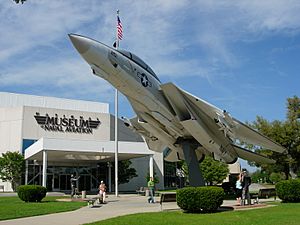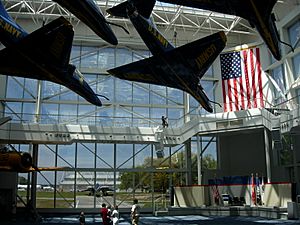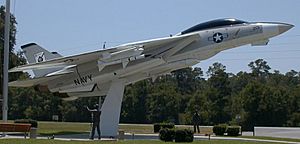National Naval Aviation Museum facts for kids

F-14A Tomcat in front of the National Naval Aviation Museum (front-left view)
|
|
| Lua error in Module:Location_map at line 420: attempt to index field 'wikibase' (a nil value). | |
| Former name | National Museum of Naval Aviation and Naval Aviation Museum |
|---|---|
| Established | 1962 |
| Location | Pensacola, Florida |
| Type | |
| Founder | Rear Admiral Magruder H. Tuttle |

The National Naval Aviation Museum, formerly known as the National Museum of Naval Aviation and the Naval Aviation Museum, is a military and aerospace museum located at Naval Air Station Pensacola, Florida.
Overview
The museum is devoted to the history of naval aviation, including that of the United States Navy, the United States Marine Corps, and the United States Coast Guard. Its mission is "to select, collect, preserve and display" appropriate memorabilia representative of the development, growth and historic heritage of United States Naval Aviation. More than 150 aircraft and spacecraft are on display, including four former Blue Angels A-4 Skyhawks, the Curtiss NC-4 (the first aircraft to cross the Atlantic), U. S. Coast Guard helicopters, biplanes, a K-47 Airship control gondola and tail fin, an aircraft that President George H. W. Bush trained in, and the S-3 Viking used to transport President George W. Bush to the USS Abraham Lincoln in 2003 (see Navy One). These historic and one-of-a-kind aircraft are displayed both inside the Museum's 300,000 square feet (30,000 m2) of exhibit space and outside on the Museum's 37-acre (150,000 m2) grounds. The museum also functions in coordination with the Naval Air Systems Command (NAVAIRSYSCOM or NAVAIR) as the Navy's program manager for nearly all other retired Navy, Marine Corps and Coast Guard aircraft on display aboard U.S. military installations in the United States or overseas, or in numerous other museums or public displays. In a similar manner to U.S. Air Force aircraft on loan from the NMUSAF's collection which remain under official USAF ownership, these other American-preserved naval aircraft continue to remain the property of the Department of the Navy and are typically identified at these locations as being "On Loan from the National Naval Aviation Museum."
In addition to the displays, the museum features a Giant Screen Theater, flight simulators, Blue Angels 4D Experience, museum store, and cafe. The Cubi Point Café is itself an exhibit as it displays squadron memorabilia from the closed NAS Cubi Point Officers' Club.
Also housed within the walls of the museum is the Emil Buehler Naval Aviation Library. The Emil Buehler Naval Aviation Library was established in 1992 with funding from the Emil Buehler Trust and now serves as a non-circulating repository for the National Naval Aviation Museum. The library’s namesake, Emil Buehler, was an aviation pioneer who had a profound impact upon the aviation community and his legacy lives on through his philanthropic trust and education programs in colleges throughout the Florida and the eastern United States. The Buehler Aviation Library is home to artifacts and special collections of items from people and events that are of monumental importance to not only the history of aviation in America but also Naval history in general. The collection contains books, oral histories, pictures, manuscripts, technical manuals and approximately 400,000 photographs, many of which are searchable and organized The library houses special collections like a sampling of the earliest tales gathered by members of the Brown Shoe Project, who have compiled stories and histories of aviation squadrons that flew missions during the Korean War and is also actively involved in hosting celebrations commemorating significant events like the 50th Anniversary of the Apollo 11moon landing in 2019. Similarly, one of Naval Air Station Pensacola’s own trainees was a member of that historic Apollo 11 mission. and the library also maintains Buzz Aldrin’s flight training records from the early days of his Naval career. The Emil Buehler National Aviation Library is considered one of the most complete sources of Naval history in the United States.
National Flight Academy
Adjacent to the museum and library is the National Flight Academy, a four-story simulated aircraft carrier housing over 30 networked flight simulators. Throughout the summer, more than 200 students per week (7th through 12th grade) from across the nation attend the National Flight Academy's 6-day program, designed to inspire attendees to pursue a future in STEM (science, technology, engineering and mathematics).
The museum is supported by a 501(c)(3) educational non-profit organization, the Naval Aviation Museum Foundation. Since 1966, this foundation has raised tens of millions of dollars to construct the museum, build exhibits, recover and restore aircraft, and develop educational programs like the National Flight Academy.
Practice demonstrations by the United States Navy Flight Demonstration Squadron, the Blue Angels, may be viewed from the museum most Tuesday and Wednesday mornings between March and November. These practices are weather permitting, and a tentative practice schedule may be viewed on the Blue Angels' website.
Captain Robert L. Rasmussen, a retired Navy captain, former Navy fighter pilot and former Blue Angels demonstration pilot, served as museum director for 27 years and reported to the Naval History & Heritage Command. Also an artist, some of his works are displayed in the museum. Captain Rasmussen retired as director in 2014 and was replaced by Captain Sterling Gilliam, Jr.
History
The museum was established 14 December 1962 with the initial facility located in a cramped 8,500 square foot building aboard the air station that had been erected during World War II and which was dedicated in June 1963. The Phase I portion of the current facility was dedicated Sunday 13 April 1975, although it had been informally open since November 1974. Construction of the new location began in November 1972. The Phase II portion was completed in 1980, followed by the Phase III portion in 1990.
The museum and some of its aircraft on display outside were damaged by Hurricane Ivan in September 2004.
Collection

- Beechcraft GB Traveller
- Beechcraft SNB-5P Expeditor
- Beechcraft T-34 Mentor
- Bell AH-1 Sea Cobra
- Bell HTL-4
- Bell HTL Sioux
- Bell HH-1K Iroquois
- Bell TH-57 Sea Ranger
- Boeing CH-46 Sea Knight
- Boeing F4B-4
- Brewster SB2A Buccaneer
- Cessna JRC Bobcat
- Cessna O-1 Bird Dog
- Consolidated N2Y
- Consolidated PBY Catalina (Suspended)
- Consolidated PBY Catalina (Cutaway)
- Consolidated PBY Catalina (Flight Line)
- Consolidated PB2Y Coronado
- Consolidated PB4Y-2/P4Y-2G Privateer
- Convair C-131 Samaritan
- Curtiss A-1 Triad
- Curtiss BFC Goshawk
- Curtiss F6C Hawk
- Curtiss F7C Seahawk
- Curtiss JN-4D Jenny
- Curtiss Model F
- Curtiss NC-4
- Curtiss N2C Fledgling
- Curtiss P-40 Tomahawk
- Curtiss-Wright R5C Commando
- Curtiss-Wright SNC Falcon
- de Havilland Canada NU-1B Otter
- Douglas AD Skyraider
- Douglas A3D Skywarrior
- Douglas A-4A Skyhawk
- Douglas A-4E Skyhawk
- Douglas A-4 Skyhawk (Blue Angels)
- Douglas A-4 Skyhawk (Blue Angels)
- Douglas A-4 Skyhawk (Blue Angels)
- Douglas A-4 Skyhawk (Blue Angels)
- Douglas R4D-5L Skytrain
- Douglas C-117D (R4D-8) Skytrain
- Douglas R6D/C-118 Liftmaster
- Douglas Dolphin
- Douglas F3D Skyknight
- Douglas F4D Skyray
- Douglas D-558-1 Skystreak
- Douglas JD Invader
- Douglas SBD Dauntless (Underwater Display)
- Douglas SBD Dauntless (Midway Veteran)
- Fokker D.VII
- Ford RR-5 Trimotor
- Franklin PS-2 glider
- General Dynamics F-16N Viper
- General Motors FM-2 Wildcat (Quarterdeck)
- General Motors FM-2 Wildcat (Pacific Island)
- General Motors TBM Avenger
- Goodyear FG-1D Corsair
- Goodyear K-47 Airship Control Car
- Goodyear L-8 Airship Control Car
- Goodyear ZPG-2 Control Car
- Grumman A-6 Intruder
- Grumman AF Guardian
- Grumman C-1 Trader
- Grumman E-1 Tracer
- Grumman E-2 Hawkeye
- Grumman FF
- Grumman F3F
- Grumman F4F Wildcat (Underwater Display)
- Grumman F4F-3 Wildcat
- Grumman F4F-3A Wildcat
- Grumman F6F-3 Hellcat
- Grumman F6F-5 Hellcat
- Grumman F7F Tigercat
- Grumman F8F Bearcat
- Grumman F9F-2 Panther
- Grumman F9F-6 Cougar
- Grumman F9F-8 Cougar
- Grumman F11F Tiger
- Grumman YF-14A Tomcat (Pedestal outside)
- Grumman F-14D(R) Tomcat
- Grumman F-14A Tomcat
- Grumman HU-16 Albatross
- Grumman J2F Duck
- Grumman J4F Widgeon
- Grumman JRF Goose
- Grumman S2F Tracker
- Grumman TC-4C Academe
- Hanriot HD.1
- Hawker Siddeley AV-8C Harrier
- Hiller HTE
- Interstate TDR
- Kaman H-2 Seasprite
- Kawanishi N1K2 Shiden
- Lockheed C-130T Hercules (Fat Albert)
- Lockheed EC-121 Warning Star
- Lockheed KC-130F Hercules
- Lockheed L-10 Electra
- Lockheed PV-2 Harpoon
- Lockheed P2V-1 Neptune (Truculent Turtle)
- Lockheed P2V-7/SP-2H Neptune
- Lockheed P-3A Orion
- Lockheed S-3 Viking (ex-Navy One)
- Lockheed TV-2
- Martin AM Mauler
- Martin SP-5B Marlin
- McDonnell FH Phantom
- McDonnell F2H Banshee
- McDonnell F2H-2P Photo Banshee
- McDonnell F3H Demon
- McDonnell Douglas C-9 Skytrain II
- McDonnell-Douglas F-4N Phantom II
- McDonnell Douglas F/A-18 Hornet (Blue Angels)
- McDonnell Douglas F/A-18 Hornet (Tactical)
- McDonnell-Douglas RF-4B Phantom II
- Messerschmitt Me 262
- Mikoyan-Gurevich MiG-15
- Mitsubishi A6M Zero
- Naval Aircraft Factory N3N-3 Canary (Wheels)
- Naval Aircraft Factory N3N-3 Canary (Floats)
- New Standard NT-1
- Nieuport 28 C.1
- North American AJ Savage
- North American FJ-2 Fury
- North American FJ-4 Fury
- North American PBJ Mitchell
- North American RA-5C Vigilante
- North American SNJ Texan
- North American SNJ Texan (Cutaway)
- North American T-2 Buckeye
- North American T-28 Trojan
- North American T-39 Sabreliner
- Northrop T-38 Talon
- Piasecki HUP Retriever
- Project Apollo/Skylab Command Module
- Ryan NR-1 Recruit
- Schweizer LNS-1
- Sikorsky CH-37 Mojave
- Sikorsky CH-53 Sea Stallion
- Sikorsky H-3 Sea King
- Sikorsky HH-52 Sea Guard
- Sikorsky HNS Hoverfly
- Sikorsky HO3S
- Sikorsky HO5S
- Sikorsky HSS/HUS Seabat/Seahorse
- Sikorsky SH-60B Seahawk
- Sikorsky VH-3 Sea King
- Sopwith F.1 Camel
- Stearman N2S Kaydet
- Temco TT-1 Pinto
- Thomas-Morse S-4C Scout
- Timm N2T Tutor
- Vought A-7 Corsair II
- Vought F4U-4 Corsair
- Vought F7U Cutlass
- Vought F-8 Crusader
- Vought OS2U Kingfisher
- Vought SB2U Vindicator
- Vultee SNV Valiant

